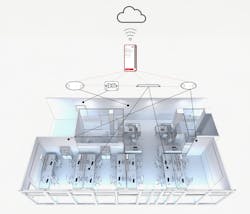Emergency lighting is an essential component of any building’s safety infrastructure. It provides illumination in the event of a power outage, fire, or other emergency, to help guide occupants toward safety. But when connected to the Internet of Things (IoT), emergency lighting can deliver even greater value — by providing building managers with advanced monitoring and testing capabilities that increase the reliability of the emergency lighting system.
Emergency lighting codes to know
Underwriters Laboratories (UL) 924 is a safety standard for emergency lighting and power equipment. It sets specific requirements, derived from National Fire Protection Association (NFPA) 101, for the design, performance, and testing of this equipment to ensure that it functions properly when it is needed most. NFPA 101 is equally important, as it puts forth the design, performance, and testing of the building’s emergency lighting system. Compliance with both UL 924 and NFPA 101 is mandatory in most locations, and failure to comply can result in fines and other penalties.
Why is testing important?
In accordance with UL 924, the testing of emergency lighting systems must occur frequently and continually. Specifically, functional testing must happen once a month for at least 30 seconds, and full duration testing must occur once per year for at least 90 minutes. These tests help ensure that emergency lighting is functioning properly during a real emergency situation.
Testing must also be documented, and that documentation must be available for review during an inspection. Failure to comply with these requirements can result in fines or even a building shutdown until its emergency lighting can be brought up to code.
Traditional manual testing methods are time-consuming and require a human operator, typically a member of the facility management or maintenance staff, to identify and correct any issues that arise. The process can involve walking a building and either climbing a ladder to press test switches or turning off circuit breakers and observing the performance of many lights at once. This process is labor intensive and, due to its manual nature, can lead to inconsistencies in testing and the potential for errors.
Self-testing devices, which automatically conduct required routine checks to ensure functionality, significantly streamline the testing process. However, even with automatic testing of these products, their status must still be manually inspected by means of the indicator light and the results logged in handwritten records. Eliminating this still labor-intensive step is part of the value of connected emergency lighting systems.
The latest connected emergency lighting technology can help building managers ensure quick and reliable code-compliant testing.
Connected emergency lighting 101
Connected emergency lighting systems employ a method of data transfer to communicate between emergency lighting devices and a central control device. Connections can be either wired or wireless and are used to transmit data (primarily emergency lighting testing results) between emergency lighting devices and a central control device.
Additionally, in some systems, commands can be sent from the central control device to the emergency lighting devices. These commands include reporting stored test results to the network, initiating a manual test or setting a custom test schedule. These functions are designed to ease the maintenance processes of the system and simplify the system interaction.
Regardless of system type or complexity, the value of connected emergency lighting is the reduction in time and effort (and therefore cost) in keeping emergency lighting systems code-compliant.
Wired vs. wireless
As mentioned earlier, networked emergency devices can be connected in wired or wireless configurations. In either case, the connected emergency lighting system will still realize the savings in maintenance dollars with automated testing and reporting. The primary difference is in the installation of the wiring in between communication nodes. For a wired system, installers must make connections to all the nodes (the emergency devices) and to a device that acts as a hub, which typically connects to a central computer. For the wireless setup, the network is established via a wireless transmission protocol, typically Bluetooth, Zigbee, or Wi-Fi.
Labor adds to the cost of implementing a wired emergency lighting system. The advantages of a wired connection are faster communication speeds and greater bandwidth. However, there are very few situations where this may result in a measurable benefit. An example of this would be in downloading data from a larger installation, which has hundreds of communication nodes. A campus with multiple buildings and any facility greater than 50,000 square feet would be considered a large installation. In smaller installations, the speed/bandwidth of a wireless system is typically more than adequate. Plus, the reduced installation costs are attractive.
Stand-alone systems vs. gateway connected
There are primarily two types of connected emergency lighting systems — stand-alone and gateway. Stand-alone, as the name implies, is separate from other building automation systems and can function without interfacing with any other lighting control system. The connected emergency lighting hardware connects directly to a device, such as a smartphone or tablet. Stand-alone systems can function on their own, without interfacing with any other system, require less financial investment, and are easier to install, making them a better choice for smaller facilities.
The gateway system is typically part of a larger overall control system that can be accessed from a terminal (desktop or laptop) through a dashboard. The emergency lighting system would be integrated into the overall building automation system with system status and test results available through options on the dashboard. Gateway systems provide real-time monitoring and automatic notification of test failures and give automatic updates through the gateway to the dashboard — they are generally a better choice for larger facilities.
Both systems have advantages and disadvantages but, in both, a network is used to relay information between emergency lighting devices and a central controller to simplify the maintenance and code compliance of emergency lighting systems.
Automated compliance testing and reporting
Connected emergency lighting makes the UL 924 code-required periodic testing easier. Its automated testing can significantly reduce the associated labor, thereby reducing maintenance costs. These systems can also perform automatic testing at regular intervals and at specified times, meaning less interruption of a building’s normal schedule. This is particularly important for certain sensitive locations, such as hospital operating rooms, where self-testing with randomized schedules cannot be done, as it may interrupt the normal use of the location. In these instances, manual testing was previously the only option, which would typically mean testing during odd hours. Now, facility managers can have peace of mind knowing that the system is ready to perform with the scheduled testing.
Connected UL 924 emergency lighting systems can also auto-generate compliance testing reports and system status data. This can be particularly useful for building managers, who are required to show compliance with safety regulations and provide evidence of regular testing and maintenance. Auto-generated reports save time and resources and provide a clear record of the emergency lighting system’s performance. These reports typically contain details regarding the product’s status, and in the event of any errors during testing, they help in identifying these issues, thereby significantly facilitating subsequent troubleshooting, repair, or replacement processes.
Some connected emergency lighting systems can also provide real-time monitoring capabilities, allowing building managers to track the emergency lighting system status 24/7/365. This can be particularly important in large buildings or corporate campuses, where multiple emergency lighting systems need to be managed. Real-time monitoring ensures that maintenance can be scheduled based on real-time data, reducing the need for unnecessary maintenance and ensuring that any issues are addressed promptly.
Maintain your emergency lighting compliance
Connected UL 924 emergency lighting systems provide numerous benefits over traditional emergency lighting solutions. Automated testing with advanced monitoring and reporting capabilities improves the reliability of the emergency lighting system while also reducing maintenance costs.
Since compliance with UL 924 is mandatory for nearly all routinely occupied public buildings, it is essential to ensure that your emergency lighting system is up to date and functioning correctly. With connected UL 924 emergency lighting systems, building managers can provide their occupants with the peace of mind that comes with knowing their emergency lighting system is always ready to perform if and when needed.
TOM STOLL is product manager and SEAN CASH is product and channel marketer for Signify’s Bodine emergency lighting product portfolio, providing solutions and support for code-compliant LED, fluorescent, and auxiliary-powered lighting systems such as those described in this article.
Follow our LinkedIn page for our latest news updates, contributed articles, and commentary, and our Facebook page for events announcements and more. You can also find us on the X platform.







